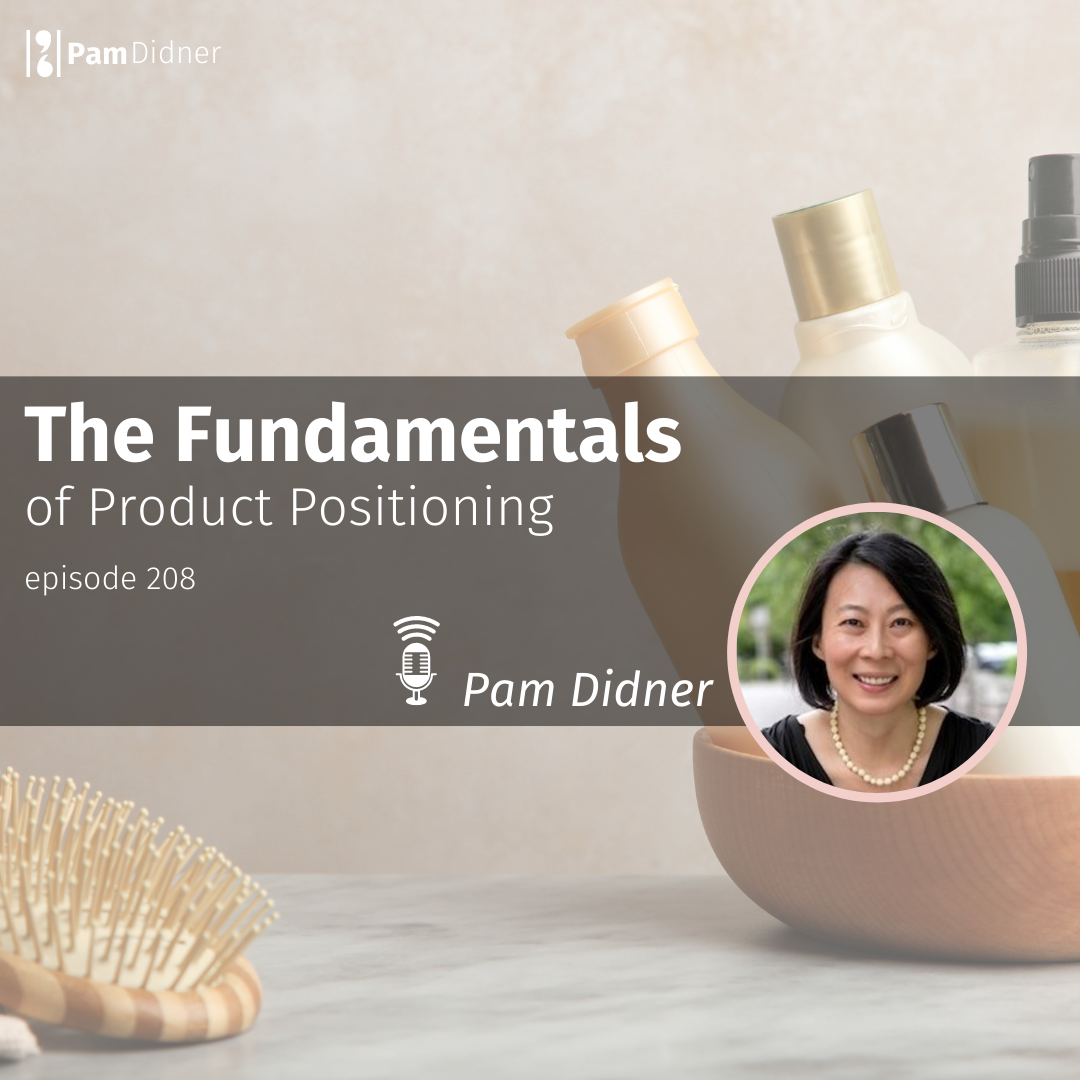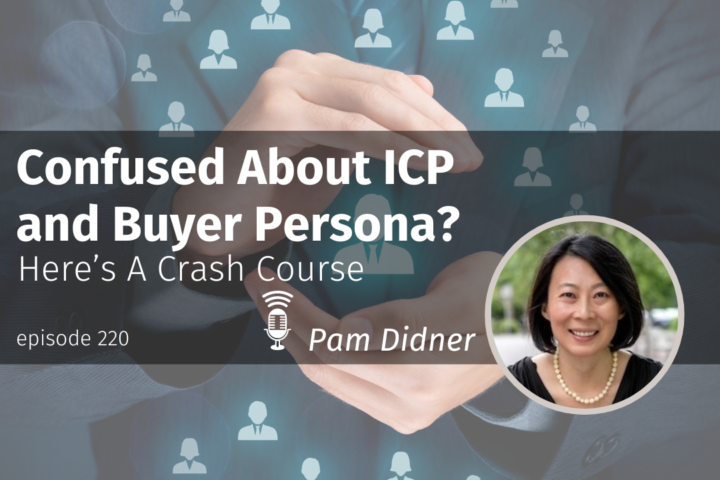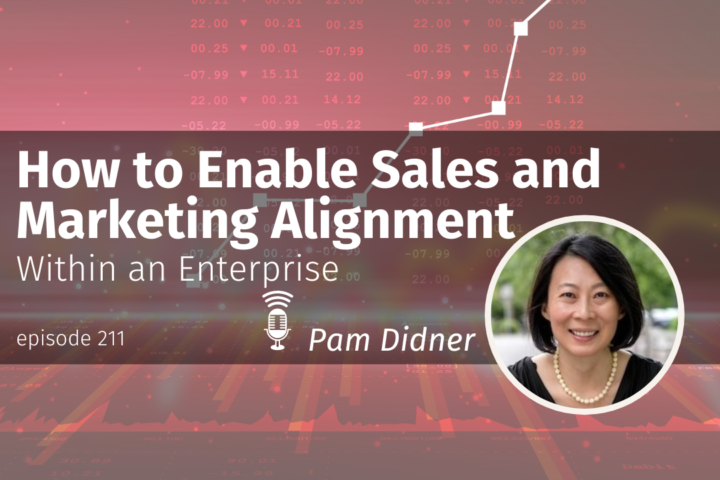
Hello from Raleigh, North Carolina. It’s time for my monthly solo episode. Today I want to talk about the fundamentals of product positioning.
It’s not a popular topic, but marketers need to understand what must be done to position their products. My product positioning tips will help you with content marketing, copywriting for social media, understanding your products, and overall marketing communications.
In this episode:
- What is product positioning?
- What is the difference between product positioning and the messaging framework?
- How to position the products?
Quotes from the episode:
“Segmentation can get complicated quickly when you constantly add new product lines or serve different sets of customers. When your company is growing, you offer more products. Over time your segmentation would get messy. You will need to reevaluate your segmentations. ”
“The purpose of a name is to evoke a visual in a person’s mind. Therefore naming or not naming your product is a strategic decision. However, you should always have a short and differentiated description to explain your product.”
—————
Enjoy the podcast? Subscribe to the show on your favorite podcast platform, leave a 5-star review and subscribe to Apple Podcasts.
If you prefer watching a video, I also have a YouTube Channel; check it out and subscribe.
If you want to chat, reach out to any social media channels or email me at hello@pamdidner.com. You can also join my Facebook community: Build Your Marketing Skills to Get Ahead. When you join, you get a free Starbucks on me. You can go to the Announcement tab and click on the barcode of the gift card.
To expand your knowledge check out more product positioning tips in my previous podcast episodes, blog posts, and videos.
Podcast episodes
Bridging the Gap Between Marketing and Product Experience
Messaging Framework: Product-Specific Template
Marketers, Get to Know Your UX Designers
Blog post
How Product Positioning Will Help You Build Your Messaging Framework
How to Create A Solid Messaging Framework: A Guide for B2B Marketers (+ Templates)
Video
How To Create a Product Positioning Strategy
How to Create A High-Volume Product Messaging Framework
TRANSCRIPT
Hello from Raleigh, North Carolina. It’s time for my monthly solo episode. Today I want to talk about the fundamentals of product positioning. It’s not a popular topic, but marketers need to understand what must be done to position their products. My product positioning tips will help you with content marketing, copywriting for social media, understanding your products, and overall marketing communications.
This topic came about when Cliff asked me to create a messaging framework. After a 15-minute discussion, we realized I couldn’t do it because he hadn’t clearly articulated his products yet. I talked to him about what he needs to do to develop product positioning. So after this episode, you’ll have tools and basic knowledge on how to develop product positioning.
I will answer three questions in this episode.
#1: What is product positioning?
#2: What is the difference between product positioning and the messaging framework?
#3: How should I go about positioning my products?
If these questions sound foreign to you, I promise it’s not as complicated as it seems. So let me break it down. And if you like the way I explain things, I would appreciate it if you could subscribe to my podcast on your favorite listening platforms.
So first things first: positioning your product is super important.
You can’t market unless, you know, clearly–I mean, clearly–why you are selling and how it is in your market. Once you know where you stand, you’ll better grasp what to communicate. Does that make sense? So what is product positioning? Product positioning is deciding and communicating how you want your audience to think and feel about your product. What is the experience you want to provide? What is the first thing you want your customer base to think when they hear about your product? Also, what is the first word they would say when they see your product?
I know you can’t control the entire thought process, but you can influence them through what you want them to know and why you want to share. You can educate them. In many ways, product positioning has been mixed or part of a custom experience, brand personas, or even the design of your products. Just think about the physical look and feel of your products, your stores, your logos, your content, even your whole communication style.
All of these can influence how others think and feel about your products. So it sounds very abstract. I know. But to make the concept feel more concrete, there are four elements I would like to share so it’s easy for you to define your product positioning. I’ll get to that shortly. All right. But before I do that, I want to address another source of confusion. What is the difference between product positioning and the messaging framework?
Remember how I said that product positioning is how your audience thinks and feels about your product?
A messaging framework is a logical and structured representation of your products and services’ unique promises and differentiation. All right. That formal definition sounds like blah, blah, blah. Let me explain to you in another way. Product positioning is what? What is your product about? What should customers think and feel when they hear about your product? The messaging framework is how you talk about your product to your customers?
So to make a simple product positioning is “what”, and the messaging framework is “how.” You need to define, develop and finalize your product before determining what to say and how to say it. Therefore the product positioning will come first, and the messaging framework will come second. So let me sidetrack a little. If you want to know about developing a messaging framework, I wrote a comprehensive, I mean, very comprehensive blog post. The title of the blog post: How to Create a Solid Messaging Framework: a Guide for B2B Marketers.
Since you are listening, you don’t need to memorize the blog title; just Google “messaging framework”, “Pam Didner”, and the post should come up. If you are a YouTube person, I created three messaging framework videos to watch; each video is about six to eight minutes. Go to YouTube type “messaging frameworks,” “Pam Didner” my video should come up. If you can find them, simply email me at hello @pamdidner.com, and I’ll send you the links.
Okay. Now that’s circle back.
We have talked about the product positioning so far. I’ve covered number one, the definition of product positioning. Number two is the differences between product positioning and the messaging framework. Number three: the sequence of developing product positioning and messaging framework. These two terms seem complicated and overwhelming, but now you know the key differences. It’s not that hard.
The last question we need to tackle is the elements to be included in developing your product positioning. Since it’s all about the look and feels and guiding people’s thought processes, you need to decide if you need to name your product? What is a short description of your product? What do you want to call your product, or should a product name be the same as your company name? There are mainly strategic discussions at the executive level when it comes to naming your products.
You may not be the decision-maker. That’s okay. But you need to understand the logic behind whether to name or not to name. A unique name would evoke a vision or spark imagination in a person’s mind. For example, if you know, my name is Pam Didner, you have heard me speak at the conference. So when someone says Pam Didner, a visual would naturally come to your mind. How I presented myself during that session subconsciously conveys how you feel about me. So a name is important.
Then another question arises: should a company’s name be your product name?
If you only offer one product, chances are it’s okay that your company name represents your product. In the past 15 years, many SaaS-based companies have created their categories. They use exciting names such as Asana, Monday, Harvest, Box, et cetera to name their companies; their products are their company names. That’s great.
Suppose you use an interesting or creative word for your product. In that case, you need to immediately explain your product after the name. Does that make sense? For example, when people see the word Asana, they immediately think, what is that? Therefore, your short description should explain the what question right away so that potential customers instantly form a product visual in their minds. “Asana. Huh? What is that?” Oh, it manages your projects, your work and tasks online. Oh, so it’s an online project management tool. Cool. I got it.” No confusion.
Suppose your company are growing fast and you offer many product lines. In that case, you may need to create different names for different product lines. Many growing B2B companies tend to pick solid names so that people can visualize the products immediately. A great example is cyber security firms. They tend to use wars related to “auto shield” “seamless defense” to name their products because it’s easy for your customer to read and visualize them.
So the purpose of a name is to evoke a visual in a person’s mind.
Therefore naming or not naming your product is a strategic decision. However, you should always have a short and differentiated description to explain your product. Naming and the differentiated product description are the first two elements of product positioning. The next element is the logo. Should you give your product a logo, or is the corporate logo good enough to help your customers visualize your product in their minds? Again, this is another strategic discussion. Logos are good visual aids to help crystallize your products in your customer’s minds. So if you have a product name, I would recommend having a logo associated with it. The logo can be a simple design of your product name with a great font. That by itself is a logo.
The last element is product segmentation. Product segmentation is complicated. Many companies spend thousands of dollars doing product segmentation. I am not going to talk about what to do and how to do it today, but I want to share with you the thought process. You can segment the same product to different audiences. The best example is Uber Share Uber, Uber Acts, or even Uber Eats. It’s the same ride but targets different customer segments for their specific needs.
You can also modify your products to different tiers with unique features to target more customers.
Many SaaS-based companies, product offerings are Free, Basic, Pro and Enterprise. It’s the same product but with different featured peers and service levels, serving different customers. Another well-known example of segmentation is BMW 3 series, 5 series and 7 series. That’s a very well-known segmentation. Recently there is also the BMW I series and BMW M series.
So as you can see, segmentation can get complicated quickly when you constantly add new product lines or serve different sets of customers. When your company is growing, you offer more products. Over time your segmentation would get messy. You will need to reevaluate your segmentations. I did segmentation overhauls, simple ones, for several clients. Man, it is a lot of work.
So here is a quick wrap up.
Number one, you need to define your product before creating a messaging framework. Number two, product positioning is the “what”; define and decide how you want your customer to think and feel about your products. And number three, the messaging framework is the “how”–how to communicate your product’s uniqueness and promises. Number four, product positioning can be complicated. Still, there are at least four concrete elements to consider: naming, description, logo, and segmentation.
Honestly, product positioning, corporate culture, brand persona, customer experience, design of your product, even user interface are all interconnected. These elements will start bubbling up when you talk about naming description, logo, and segmentation. You need to discuss these factors internally and collectively, have great debates among the team members, align everyone before you can move forward. Product positioning is a lengthy process. In a smaller company, chances are you can do it on your own. A bigger company usually hires outside consultants to facilitate that process. We can position our products, however, whenever, whatever we want.
Ultimately we can control how customers think and feel about our brands and the products.
We can focus on what we can control: define our products well and make the best possible effort to present them. But most importantly, let’s find ways to serve our customers better. I hope this episode provides you with a basic understanding and the thought process of the product. All right. Again, if you like it, subscribe and comment until next time. Take care. Bye.
I love hearing from my podcast listeners. Feel free to reach out to me on LinkedIn, Twitter or Instagram, or you can shoot me an email – at hello@pamdidner.com. And if you are looking to learn more about content marketing, sales enablement, strategic planning, account-based marketing or anything B2B marketing related, head over to my website pamdidner.com. You’ll find videos, blog posts, templates, and much more to help you on your B2B. Again, thank you so much for listening. See you back here next week.


